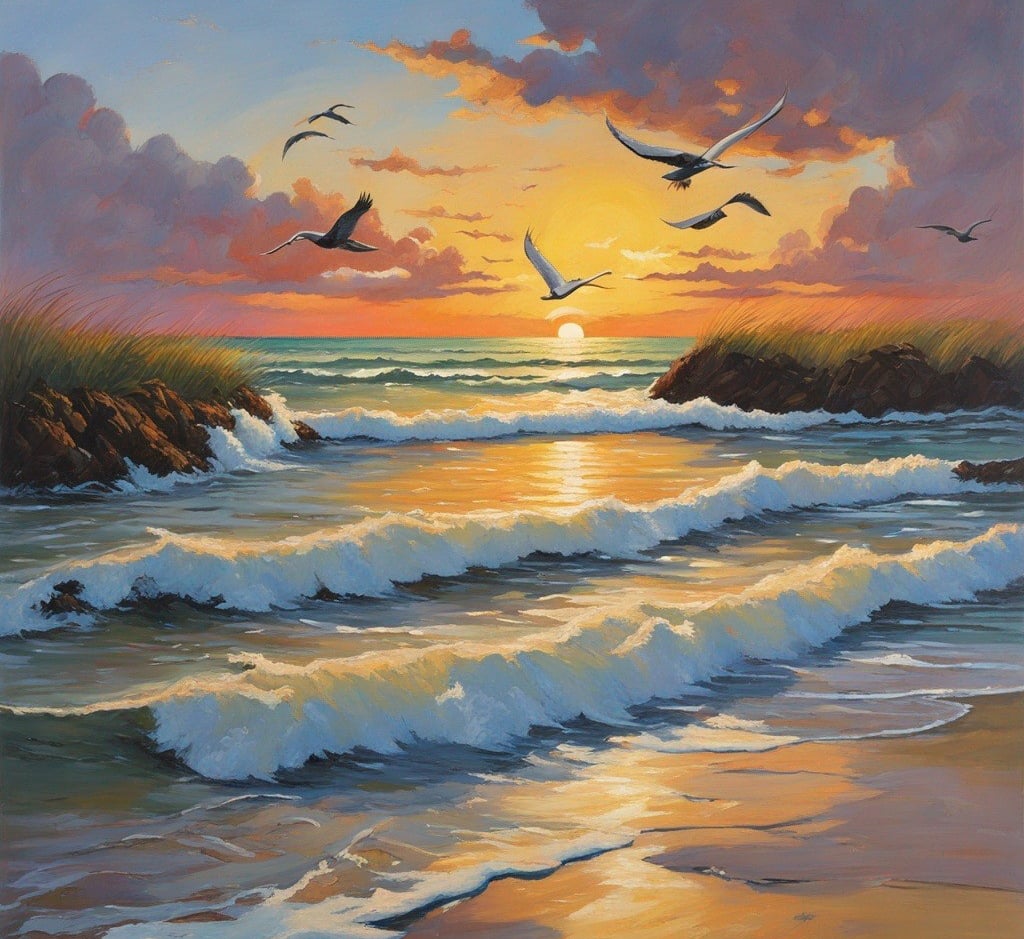Where Sea Meets Sky
There's a moment each evening when the ocean seems to catch fire—when the boundary between water and sky blurs, when seabirds become silhouettes against a canvas of impossible colors, and when time itself appears to slow in reverence for the day's grand finale.
ART
5/1/20256 min read


I've always been a collector of sunsets. Not in photographs, though I've taken hundreds over the years, each one failing in some essential way to capture what made the moment special. No, my collection exists in memory—specific evenings when the combination of light, location, and circumstance created something so perfect it demanded to be remembered.
The most treasured pieces in this collection are coastal sunsets, those extraordinary convergences of elements that occur where land meets sea. There's something about this particular setting for day's end that transcends mere natural beauty, something that speaks to deeper human needs for closure, transition, and perspective.
My obsession began on a summer evening nearly twenty years ago on a small beach in Northern California. I'd spent the day hiking through redwood forests, my mind cluttered with work deadlines and relationship complications. As afternoon waned, I found myself drawn to the coast, parking at a small turnout and following a trail through wind-sculpted cypress trees to a crescent of sand embraced by rugged headlands.
I wasn't alone—a dozen or so others had gathered, some with cameras, some with wine in plastic cups, some simply standing silent and attentive. All faced west, where the sun approached the horizon, its light already taking on that distinctive golden quality that transforms ordinary scenes into the sublime.
What followed was a master class in color theory and atmospheric optics that no human artist could fully replicate. As the sun descended, the palette shifted from gold to amber to coral, with bands of purple emerging at the periphery. The ocean surface, slightly rippled by an evening breeze, fractured these colors into millions of shimmering fragments, a mosaic of light constantly reshaping itself with each wave.
Seabirds—gulls and pelicans mostly—traced lazy circles in the darkening sky, occasionally diving into the water or skimming just above the surface. Their silhouettes, perfect black cutouts against the blazing background, added a sense of scale and movement to the tableau. When a formation of pelicans flew directly across the setting sun, their prehistoric profiles strung like beads on an invisible thread, an audible murmur of appreciation rose from the assembled humans.
As the sun made its final descent, touching the horizon and then sinking into it with surprising speed, a ritual as old as human consciousness played out among the spectators. Phones and cameras were raised, attempting to preserve the unphotographable. Couples drew closer together. A few individuals, myself included, simply stood with arms crossed or hands in pockets, bearing witness in silence.
Something happened to me in those moments—a shift in perspective, a recalibration of priorities. The problems that had seemed so urgent earlier that day didn't vanish, but they assumed their proper scale in the face of this daily cosmic event. The sunset offered no solutions, but it provided something perhaps more valuable: context.
Since that evening, I've sought out coastal sunsets whenever possible, not just as aesthetic experiences but as necessary resets for an overactive mind. I've watched the sun disappear into the Mediterranean from Greek islands, set behind volcanic peaks from Hawaiian beaches, sink into monsoon clouds from India's western coast. Each location offers its own specific magic, its own interplay of elements.
What fascinates me most is how universal the appeal of these moments proves to be. Across cultures and throughout history, humans have been drawn to witness day's end at the edge of oceans. Ancient temples from Peru to Indonesia were positioned to frame the setting sun over water. Indigenous stories from every coastal culture incorporate sunset imagery and symbolism. Modern resorts design their entire properties around optimizing sunset views.
This shared appreciation isn't merely aesthetic. Something deeper draws us to these transitional moments where elements meet and boundaries blur. Perhaps it's the visible reminder of cosmic scale, the humbling recognition of our small place in an immense system. Perhaps it's the perfect metaphor for endings and beginnings, for the cycles that govern existence. Or perhaps it's simply the shared experience of beauty so profound it momentarily suspends our differences.
On a beach in southern Portugal, I once found myself standing among strangers from at least a dozen countries, judging by the languages I overheard. As the sun approached the Atlantic, conversations quieted. When it finally disappeared with the fabled "green flash"—a rare optical phenomenon where the last fragment of sun appears emerald for a split second—an appreciative "ahhh" rose from the crowd in perfect unison. No translation needed. No cultural context required. Just humans recognizing something extraordinary together.
The best coastal sunsets, I've found, involve a certain set of conditions. Some cloud cover is essential—not enough to obscure the sun but sufficient to catch and reflect its light, turning the entire sky into a canvas. A slight breeze provides texture to the water surface without creating so much chop that the reflections fracture completely. And wildlife—birds especially—adds that crucial element of life and movement against the mineral stillness of earth and water.
But the human element matters too. Who we share these moments with, or whether we experience them in solitude, becomes part of their meaning. A sunset watched alone invites introspection, almost meditation. The same sunset shared with someone you love becomes a different experience entirely—a mutual witnessing that often encourages the kind of meaningful conversation that can be difficult in everyday settings.
Some of my most important life conversations have occurred during or immediately after coastal sunsets, as if the beauty and perspective provided by the experience creates the perfect conditions for honesty, vulnerability, and clarity. Marriage proposals. Career decisions. Reconciliations. Farewells. These threshold moments in human relationships seem to align naturally with the threshold between day and night.
"People are like islands," a friend once told me as we watched the sun sink into the Pacific from a California beach, "separated by water but connected underneath." The observation struck me as particularly apt in that moment, as strangers gathered along the shoreline, physically distant but united in attention, all experiencing the same natural phenomenon through their own particular lenses.
That's the paradox of sunset-watching—it's simultaneously universal and deeply personal. No two people see exactly the same sunset, even standing side by side. Our perceptions, colored by mood, experience, and expectation, ensure that each person's sunset is unique to them. Yet the shared recognition of beauty creates a momentary community among observers, a silent acknowledgment of common ground.
I'm reminded of this whenever I find myself on a beach at day's end. The particulars change—sometimes I'm alone, sometimes with family or friends. Sometimes the weather cooperates perfectly, sometimes clouds obscure the main event. Sometimes the beach is crowded, sometimes nearly empty. But the essence remains: humans pausing to witness a daily miracle, finding meaning in the meeting of earth, water, and light.
Last summer, I found myself on a small beach in Oregon, mesmerized by one of those perfect convergences of conditions—scattered clouds catching fire in shades of magenta and gold, waves rolling in with meditative rhythm, seabirds wheeling against the darkening sky. A young family stood nearby, their small daughter experiencing perhaps her first conscious sunset, pointing excitedly at the colors and birds.
"Where does the sun go?" she asked her father, her voice carrying clearly in the evening air.
"It doesn't really go anywhere," he explained. "The earth turns away from it. It'll come back tomorrow."
"Promise?" she asked.
"Promise," he said.
Their exchange captured something essential about why we gather at shorelines to watch daylight fade—the reassurance of continuity amid constant change, the certainty of return within the cycle of loss. The sun sets only to rise again. The tide recedes only to advance once more. In a world of uncertainties, these rhythms provide a foundation we can trust.
As twilight deepened and true darkness began to claim the beach, most spectators drifted away, heading to dinners or homes or hotels. A few lingered, watching stars emerge above the darkened water. The young family remained longest, the child clearly reluctant to leave, still pointing at new discoveries—the first star, the running lights of a distant ship, the phosphorescent foam at the edge of waves.
I understood her reluctance perfectly. The magic doesn't end when the sun disappears—it transforms, becoming subtler but no less extraordinary. The gradient of colors that unfolds after sunset, from orange to indigo to deepest blue, offers its own specific beauty. The first stars appearing, the moon rising, the boundary between sea and sky gradually dissolving in darkness—these aftereffects deserve witnessing too.
Eventually, even the most dedicated sunset-watchers must leave the beach. The temperature drops. Hunger asserts itself. Other responsibilities call. But something of the experience remains with us, a recalibrated perspective that can infuse ordinary moments with newfound appreciation.
In a world increasingly defined by artificial light and digital screens, by schedules and deadlines, by metrics and algorithms, the daily surrender of sun to sea offers a necessary reminder of what lies beyond human control and creation. It connects us to something older and larger than our immediate concerns—the turning earth, the ancient ocean, the light that makes all life possible.
So if you find yourself near a coastline as afternoon begins to wane, consider making your way to where land meets water. Find a comfortable spot facing west. Put away your phone (at least until the colors peak). And simply watch as one of nature's greatest shows unfolds before you—a display of light and color so common we sometimes forget its wonder, so fleeting we feel compelled to witness it, so beautiful it reminds us, if only briefly, what truly matters.
Get in touch


